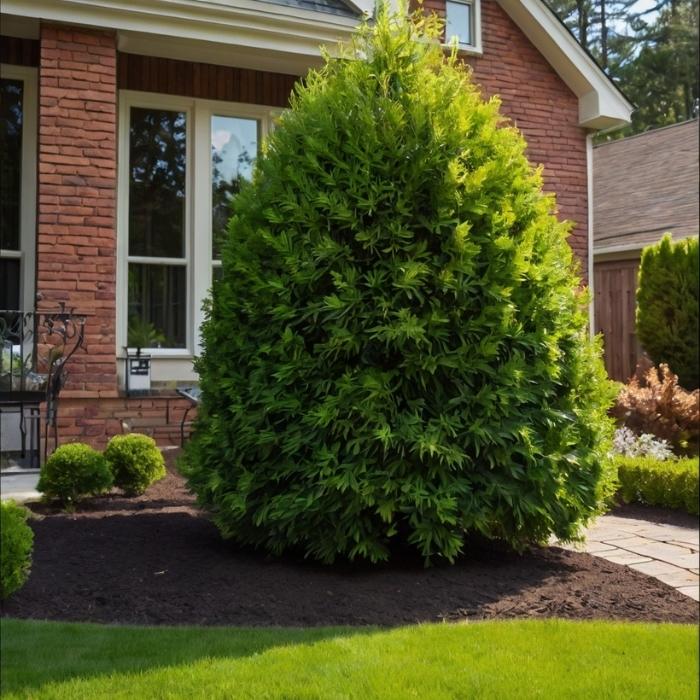How to Plant 8-Foot Green Giant Arborvitae: A Step-by-Step Guide
Green Giant Arborvitae (Thuja standishii x plicata ‘Green Giant’) is a popular evergreen tree known for its fast growth, lush foliage, and ability to create natural privacy screens. Plant an 8-foot Green Giant Arborvitae may seem daunting, but with the right preparation and care, you can ensure it thrives in your landscape. In this guide, we’ll walk you through everything you need to know to plant and care for these majestic trees.
Why Choose Green Giant Arborvitae?
Before diving into the planting process, let’s talk about why Green Giant Arborvitae is a favorite among homeowners and landscapers:
- Fast Growth: These trees can grow up to 3 feet per year, making them ideal for quick privacy screens.
- Low Maintenance: Once established, Green Giants are drought-tolerant and resistant to pests and diseases.
- Year-Round Beauty: Their vibrant green foliage stays lush and dense throughout the year.
- Versatility: They can be used as windbreaks, hedges, or standalone focal points in your yard.
Now, let’s get into the step-by-step process of planting an 8-foot Green Giant Arborvitae.
Step 1: Choose the Right Location
The success of your Green Giant Arborvitae starts with selecting the perfect spot. Here’s what to consider:
- Sunlight: Green Giants thrive in full sun to partial shade. Aim for at least 6 hours of direct sunlight daily.
- Soil Type: These trees prefer well-draining soil. Avoid areas where water tends to pool.
- Space: Green Giants can grow up to 60 feet tall and 12-20 feet wide. Plant them at least 5-6 feet apart to allow for proper growth.
- Proximity to Structures: Ensure the tree is planted at least 10 feet away from buildings, fences, or power lines to avoid future issues.
Step 2: Prepare the Planting Site
Once you’ve chosen the location, it’s time to prepare the site:
- Clear the Area: Remove any grass, weeds, or debris from the planting site.
- Test the Soil: Green Giants prefer slightly acidic to neutral soil (pH 6.0-8.0). Use a soil test kit to check the pH and amend the soil if necessary.
- Dig the Hole: The hole should be twice as wide as the root ball but no deeper. For an 8-foot tree, the root ball is typically about 2-3 feet in diameter.
- Loosen the Soil: Break up the soil at the bottom and sides of the hole to encourage root growth.
Step 3: Plant the Tree
Now comes the exciting part—planting your Green Giant Arborvitae:
- Remove the Tree from the Container: Gently slide the tree out of its container or burlap wrapping. Be careful not to damage the roots.
- Inspect the Roots: If the roots are tightly wound, gently loosen them with your hands to encourage outward growth.
- Position the Tree: Place the tree in the center of the hole, ensuring the top of the root ball is level with or slightly above the surrounding soil.
- Backfill the Hole: Fill the hole with the original soil, tamping it down gently to remove air pockets. Avoid compacting the soil too much, as this can hinder root growth.
- Water Thoroughly: After planting, give the tree a deep watering to help settle the soil and eliminate air pockets.
Step 4: Mulch and Fertilize
Mulching and fertilizing are essential steps to ensure your Green Giant Arborvitae gets off to a strong start:
- Mulch: Apply a 2-3 inch layer of mulch around the base of the tree, extending out to the drip line. Keep the mulch a few inches away from the trunk to prevent rot. Mulch helps retain moisture, regulate soil temperature, and suppress weeds.
- Fertilizer: Use a slow-release, balanced fertilizer (10-10-10 NPK) to provide essential nutrients. Apply according to the manufacturer’s instructions, typically in early spring or fall.
Step 5: Watering and Initial Care
Proper watering is critical during the first year after planting:
- Watering Schedule: Water your Green Giant Arborvitae deeply once or twice a week, depending on rainfall. The goal is to keep the soil consistently moist but not waterlogged.
- Monitor for Stress: Signs of stress include browning foliage or drooping branches. Adjust your watering schedule if needed.
- Staking (if necessary): If your tree is in a windy area, use stakes to provide support until the roots establish themselves. Remove the stakes after 6-12 months.
Step 6: Pruning and Maintenance
Green Giant Arborvitae requires minimal pruning, but a little maintenance can go a long way:
- Pruning: Prune in late winter or early spring to shape the tree or remove damaged branches. Avoid cutting into old wood, as this can stunt growth.
- Pest and Disease Control: While Green Giants are relatively pest-resistant, keep an eye out for spider mites or bagworms. Treat infestations promptly with insecticidal soap or neem oil.
- Winter Care: In colder climates, consider wrapping young trees with burlap to protect them from harsh winter winds.
Step 7: Long-Term Care
Once established, Green Giant Arborvitae is relatively low-maintenance. Here’s how to keep it healthy for years to come:
- Annual Fertilization: Apply a balanced fertilizer each spring to promote healthy growth.
- Regular Watering: While mature trees are drought-tolerant, they benefit from occasional deep watering during dry spells.
- Monitor Growth: As your tree grows, ensure it has enough space to spread out. Trim back any branches that encroach on structures or other plants.
Common Mistakes to Avoid
Even experienced gardeners can make mistakes when planting Green Giant Arborvitae. Here are some pitfalls to avoid:
- Planting Too Deep: Burying the root ball too deep can suffocate the roots and lead to poor growth.
- Overwatering or Underwatering: Both can stress the tree and cause long-term damage.
- Ignoring Soil Quality: Poor soil can stunt growth and make the tree more susceptible to disease.
- Skipping Mulch: Mulch is essential for retaining moisture and protecting the roots.
Frequently Asked Questions
1. How fast do Green Giant Arborvitae grow?
Green Giants can grow up to 3 feet per year under ideal conditions.
2. Can I plant Green Giant Arborvitae in clay soil?
While they prefer well-draining soil, Green Giants can tolerate clay soil if it’s amended with organic matter to improve drainage.
3. How tall do Green Giant Arborvitae get?
These trees can reach heights of 50-60 feet at maturity.
4. Do Green Giants attract wildlife?
Yes, they provide shelter for birds and small animals, making them a great addition to wildlife-friendly landscapes.
Conclusion
Plant an 8-foot Green Giant Arborvitae is a rewarding project that can enhance your landscape with beauty, privacy, and shade. By following these steps—choosing the right location, preparing the site, planting correctly, and providing proper care—you’ll set your tree up for success. With a little patience and attention, your Green Giant Arborvitae will grow into a stunning, towering evergreen that you can enjoy for decades to come. Seed Types Explained: How to Choose the Best Seeds for Your

